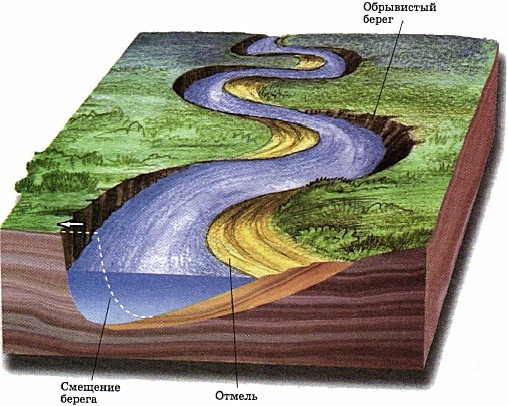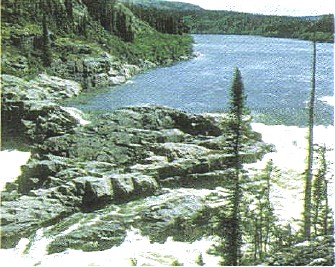How does the earth's crust affect rivers? The rivers are influenced by the terrain and the strength of the rocks that make up the earth's crust. In obedience to the force of gravity, rivers flow from high places to lower places and therefore never start from the seas or oceans. The nature of the flow of the river depends on the difference in the height of the source and mouth. In the mountains, this difference is great, so the rivers have a rapid and rapid flow. Plain rivers behave differently - they are smooth and calm, flowing slowly. Mountain rivers have relatively straight channels, while flat rivers have winding ones.
Rice. 135. Valleys: a - flat river; b - mountain river
The plain and mountain rivers have different forms of valleys. In the mountains, the river valleys are narrow and deep, on the plains they are wide with a flat bottom (Fig. 135). In mountain rivers, the depth of the valleys is many times greater than their width, because their destructive work is directed inland. The slopes of these valleys are steep, sometimes almost sheer. The bottom is entirely or almost entirely occupied by the channel.
In lowland rivers, on the contrary, the width of the valleys is greater than their depth. The destructive work of these rivers is directed not in depth, but in breadth - to wash away the banks (Fig. 136). The channel occupies only part of the flat and wide bottom of the valley.

Rice. 136. Formation of meanders on a flat river
The river erodes one of the banks, which becomes steep. The channel is gradually shifting in his direction. Near the opposite shore, shallows from river sediments and beaches are formed. Downstream, the right, tarry bank is alternately eroded. The channel becomes winding.
There are floodplains in the valleys of lowland rivers (see Fig. 135, a). During floods, water leaves fertile silt on the floodplains.
A floodplain is a part of a river valley that rises above the channel and is flooded with water only during river floods.
Rivers erode rocks of varying strength. When they cross hard rocky rocks, stone irregularities appear in the channel - rapids (Fig. 137).

Rice. 137. Thresholds
Overcoming the rapids, the river boils and foams, whirlpools appear on it. There are especially many rapids on mountain rivers, but they are also found on the plains. The rapids are very picturesque, but dangerous for navigation.
If the river encounters steep, sheer ledges of hard rocks on its way, then waterfalls are formed (Fig. 138). Angel Falls, the highest in the world, is located in South America. Its height is 1054 m. The Victoria Falls in Africa are widely known (find these waterfalls on the physical map of the world). In Russia, the highest waterfall is Ilya Muromets on one of the Kuril Islands (141 m).
The role of climate in the life of rivers. Rivers depend not only on the relief, but also on the climate. It determines the density of the river network, the fullness of the rivers and their behavior during the year.
In those areas of the globe where precipitation brings more moisture than it evaporates, there are many rivers and they are deep. The deepest river in the world is the Amazon. Every year it carries 6500 km 3 of water into the Atlantic Ocean. There are very few rivers in the deserts. Some of them even dry up or "get lost" in the sands. Find drying rivers on the physical map of the world. How are they designated? The full flow of rivers in different seasons of the year is not the same. It depends on the feeding of the river.
Feeding a river is the way moisture enters it.
![]()
Rice. 138. Waterfall
Under the influence of falling water, the waterfall constantly recedes upstream.
The rivers are fed by rain, melted snow and glaciers, as well as groundwater. There are no rivers in nature that would have one source of food. The role of different food sources varies with the seasons of the year. Depending on this, the regime of rivers is formed.
The river regime is the behavior of the river during the year.
In the regime of rivers, periods with different fullness alternate. If the amount of water in the river increases sharply, it rises, overflows the channel and floods the floodplain. The rise of water in the river, which repeats annually at the same time, is called high water.
The time of floods on the rivers is determined by the climate. Most of the lowland rivers in our country have a spring flood, it is associated with snowmelt. There is less water in the rivers in summer and winter. In winter, the rivers are covered with ice, so the only source of their nutrition is groundwater. In summer, rainwater is added to the underground supply.
Rivers in other climatic conditions have a completely different regime. For example, in the equatorial zone they do not freeze and are full of water all year round (explain why).
Questions and tasks
- How are mountain rivers different from lowland rivers?
- Under what conditions are rapids and waterfalls formed on rivers?
- Remember what monsoons are. When do monsoon climate rivers flood?
- When is the flood on the river near which you live?
